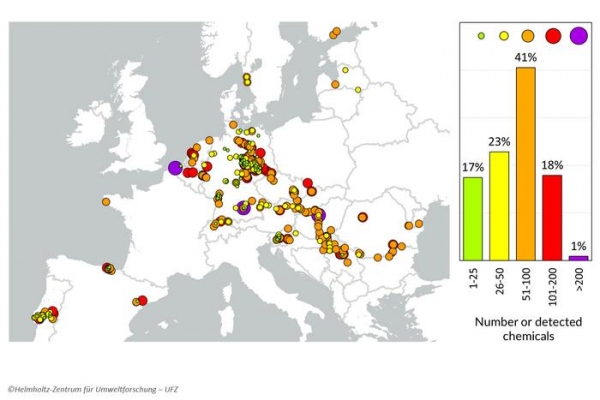UFZ analysis shows a mix of chemicals that endanger invertebrate organisms in particular.
UFZ analysis shows a mix of chemicals that endanger invertebrate organisms in particular.
It is well known that if chemicals from domestic sources enter water bodies via sewage treatment plants, agriculture, and industry, this can endanger freshwater ecosystems. In order to find out more about the pollution of European rivers, a research team from the Helmholtz Centre for Environmental Research (UFZ) analysed around 450 samples from 22 European watercourses and found more than 500 harmful chemicals, some of them in high concentrations. According to an article recently published in Environment International, these pose a high risk for invertebrates in particular.
Many pesticides, industrial chemicals, and pharmaceuticals as well as their degradation products end up in streams and rivers after use. A team of environmental chemists at the UFZ has therefore taken a closer look at 610 chemicals with known occurrence patterns or problematic effects and analysed whether and in what concentrations they occur in European watercourses - from large rivers such as the Elbe, Danube, and Rhine to the Ebro and Tagus on the Iberian Peninsula to smaller streams in agricultural regions of Germany. After analysing 445 samples from 22 rivers, the researchers detected 504 of the 610 chemicals. They found 229 pesticides and biocides and 175 pharmaceutical chemicals as well as surfactants, plastic and rubber additives, per- and polyfuoroalkyl substances (PFAS), and corrosion inhibitors. They detected up to 50 chemical substances in 40% of the samples and 51-100 chemicals in a further 41%. In four samples, they were even able to detect more than 200 organic micropollutants. They detected the most substances - 241 chemicals - in a water sample taken from the Danube.
Read more at Helmholtz Centre for Environmental Research - UFZ
Image: The size of the circles corresponds to the number of substances detected per sampling point. The colours quantify the number of chemicals detected simultaneously at a sampling site (e.g. 51 to 100 substances were detected in 41% of the sites). (Credit: UFZ)




